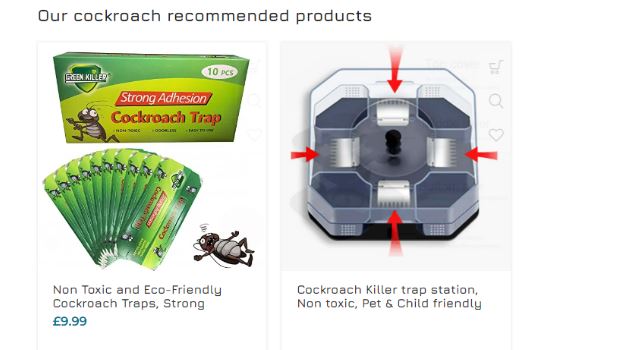- Pigeon Repellent Guide
- The Ultimate Guide to Bird Spikes
- The ultimate Guide on How to get rid of fruit flies
- Guide On How To Get Rid Of Flies Inside Your House
- How does steel wool for mice help safeguard your spaces?
- Everything you need to know about the mosquitoes | How to prevent them
- Which company is best for pest control ? How To Decide?
- What is rodent proofing and why do you need rodent proofing?
- Ultimate Guide to Get Rid Of Flying Insects UK
- Comprehensive Guide to Using Steel Wool for Mice Control
Natural ways to get rid of cockroaches | Non-Toxic & Safe
On June 15, 2023
Comments Off on Natural ways to get rid of cockroaches | Non-Toxic & Safe

Natural ways to get rid of cockroaches | Non-Toxic & Safe
Finding roaches in and around your house can be frustrating. Most of us consider finding roaches as a sign of uncleanliness. Hence tend to try numerous ways to get rid of cockroaches as soon as possible. Cockroaches can be anywhere from your kitchen to your bathroom, attic to your garage. They are so commonly found, yet we find it difficult to get rid of them. In this blog, we will share our insights on how you can avoid cockroaches in your home and effective, non-toxic ways to remove them completely.
What types of cockroaches are commonly found in your homes?
In the UK, the most common types of cockroaches found in homes are the German cockroach (Blattella germanica) and the Oriental cockroach (Blatta orientalis).

German cockroach: This species is small, light brown or tan in colour, and has two dark stripes on its pronotum. German cockroaches are prolific breeders and can infest homes quickly. They are commonly found in kitchens, bathrooms, and other areas where food and moisture are present.
Oriental cockroach: These cockroaches are dark brown or black and have a shiny appearance. They prefer cool and damp environments and are often found in basements, cellars, and drains. Oriental cockroaches are less common than German cockroaches in UK homes but can still be encountered.

While these two species are the most frequently encountered cockroaches in UK homes, it’s worth noting that other species may occasionally be found, such as the American cockroach (Periplaneta americana), though they are less common. If you suspect a cockroach infestation in your home, it’s advisable to contact a professional pest control service to properly identify the species and implement effective control measures.
Why do cockroaches enter our homes?
Cockroaches enter homes for several reasons, primarily seeking shelter, food, water, and favourable living conditions. Here are some specific factors that attract cockroaches to residential spaces:

Food sources: Cockroaches are scavengers and will enter homes in search of easily accessible food sources. They are particularly attracted to crumbs, food residues, and open containers. Kitchens and dining areas provide abundant food opportunities.
Moisture and water: Cockroaches require water to survive, so they are attracted to areas with moisture. Leaky pipes, dripping faucets, and humid environments provide the necessary water sources for them.


Warmth and shelter: Cockroaches prefer warm and protected environments. They will seek out cracks, crevices, and hidden spaces such as wall voids, cabinets, and appliances for shelter and a suitable temperature.
Entry points: Cockroaches can enter homes through small openings, gaps, or cracks in the walls, windows, doors, and foundations. They can also hitch a ride on items brought into the house, such as packages, bags, or used furniture.


Nearby infestations: If neighbouring homes or buildings have cockroach infestations, these pests can migrate and find their way into other properties, including yours.
Neglected cleanliness and sanitation: Poor sanitation and inadequate cleaning practices can attract cockroaches. Leaving food debris, dirty dishes, and garbage exposed can provide a readily available food source.

To deter cockroaches from entering your home, it’s essential to maintain cleanliness, seal any entry points, fix leaks, and store food securely. Regular cleaning, proper food storage, and good sanitation practices can significantly reduce the chances of a cockroach infestation. If you suspect or encounter a cockroach problem, seeking professional pest control assistance is recommended to effectively eliminate the infestation and prevent future occurrences.
Why are chemical cockroach repellents dangerous?

We always recommend you use chemicals as the last option. Chemical repellent can be not only dangerous to humans but also to the environment as a whole.
Chemical cockroach repellents can be dangerous for several reasons:
Health risks: Many chemical cockroach repellents contain toxic ingredients that can be harmful to human health. These chemicals may release fumes or particles that can irritate the respiratory system, eyes, and skin. Prolonged exposure or inhalation of these chemicals can lead to health issues, especially for individuals with respiratory problems, allergies, or sensitivities.
Environmental impact: Chemical repellents used to control cockroaches often contain ingredients that are harmful to the environment. These chemicals can leach into the soil, contaminate water sources, and harm beneficial insects and wildlife. They can also persist in the environment for extended periods, contributing to long-term ecological damage.
Risk of misuse: Improper use or handling of chemical repellents can pose significant risks. If not used according to instructions, excessive amounts of repellents may be applied, increasing the chances of exposure. Additionally, if repellents are stored or disposed of incorrectly, they can pose a risk to children, pets, or wildlife.
Development of resistance: Frequent use of chemical repellents can lead to the development of resistance in cockroach populations. Over time, cockroaches may become less susceptible to the chemicals, rendering the repellents ineffective. This can result in the need for stronger and potentially more hazardous chemicals to control infestations.
Alternatives available: There are safer and more environmentally friendly alternatives for cockroach control, such as integrated pest management (IPM) techniques. IPM focuses on preventive measures, sanitation practices, and the use of non-chemical control methods like traps, baits, and physical barriers. These approaches can effectively manage cockroach infestations without relying heavily on chemical repellents.
It’s important to carefully consider the potential risks associated with chemical cockroach repellents and explore alternative options that prioritise human and environmental safety. If you are dealing with a persistent cockroach problem, it’s advisable to consult with a professional pest control service that can provide effective and safe solutions.
What are the natural and non-toxic ways to get rid of cockroaches?

- Not leaving food debris on the floor. Clean well after cooking or consuming food. Food debris attracts cockroaches and all sorts of insects.
- Do not leave your pet food bowl uncleaned.
- Seal the possible entry points for cockroaches.
- Clear out those items that can possibly be the hideouts or breeding areas for the roaches
- Sprinkle baking soda in the areas where cockroaches could infest.
Pest Control Worldwide Products that help natural and non-toxic eradication of cockroaches
We at Pest Control Worldwide never support the toxic or inhuman killing of cockroaches or any insects. Our range of products supports natural or non-toxic eradication. Here are the two main products that help get rid of cockroaches:

Cockroach killer trap station
Our cockroach killer trap station features an improved trigger mechanism that is more responsive and precise compared to traditional wooden traps. Setting up the trap is now faster and easier, ensuring a quick response time to catch cockroaches effectively without giving them a chance to escape.
Here are the steps to use the trap:
- Open the cover of the box trap.
- Securely place the bait inside the trap to attract cockroaches.
- Position the trap in areas where there is a high level of cockroach activity.
By following these simple steps, you can efficiently use the trap to capture cockroaches and address the infestation effectively.
Shop here

Strong Adhesion, Odourless and Eco-friendly Trap
Adhesive-coating cockroach traps are designed with long-lasting and highly adhesive features, making them effective for capturing cockroaches and other household pests. These traps can be conveniently placed in various locations around the home, including corners and spaces where cockroaches are commonly active. They are user-friendly, as you simply need to follow the trap's guidelines to create a house shape and position it in areas frequented by roaches. The traps are constructed from non-toxic materials, ensuring a safer and more environmentally friendly approach to eliminating cockroaches. Furthermore, these traps can also be used to catch other bothersome household pests like spiders, ants, and various insects.
Shop here
